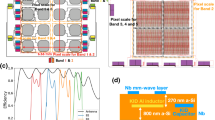Abstract
Kinetic Inductance Detectors (KIDs) provide a promising solution to the problem of producing large format arrays of ultra sensitive detectors for astronomy. Traditionally KIDs have been constructed from superconducting quarter-wave resonant elements capacitively coupled to a co-planar feed line [1]. Photon detection is achieved by measuring the change in quasi-particle density caused by the splitting of Cooper pairs in the superconducting resonant element. This change in quasi-particle density alters the kinetic inductance, and hence the resonant frequency of the resonant element. This arrangement requires the quasi-particles generated by photon absorption to be concentrated at positions of high current density in the resonator. This is usually achieved through antenna coupling or quasi-particle trapping. For these detectors to work at wavelengths shorter than around 500 μm where antenna coupling can introduce a significant loss of efficiency, then a direct absorption method needs to be considered. One solution to this problem is the Lumped Element KID (LEKID), which shows no current variation along its length and can be arranged into a photon absorbing area coupled to free space and therefore requiring no antennas or quasi-particle trapping. This paper outlines the relevant microwave theory of a LEKID, along with theoretical and measured performance for these devices.
Similar content being viewed by others
References
B.A. Mazin, Microwave kinetic inductance detectors. Ph.D. dissertation, California Institute of Technology, California, 2004
A.V. Sergeev, V.V. Mitin, B.S. Karasik, Ultrasensitive hot-electron kinetic-inductance detectors operating well below the superconducting transition. Appl. Phys. Lett. 80, 817–819 (2002)
Gao et al., Noise properties of superconducting coplanar waveguide microwave resonators. Appl. Phys. Lett. 90, 102507 (2007)
D. Pozar, Microwave Engineering, 3 edn. (Wiley, New York, 2005)
Sonnet Electromagnetic Simulation Software, http://www.sonnetusa.com
D.C. Mattis, J. Bardeen, Theory of the anomalous skin effect in normal and superconducting metals. Phys. Rev. 111, 412–417 (1958)
S. Doyle, J. Naylon, P. Mauskopf, A. Porch, C. Duncombe, Lumped element kinetic inductance detectors, in International Space Terahertz Technology Conference Proceedings, March 2007
Author information
Authors and Affiliations
Corresponding author
Rights and permissions
About this article
Cite this article
Doyle, S., Mauskopf, P., Naylon, J. et al. Lumped Element Kinetic Inductance Detectors. J Low Temp Phys 151, 530–536 (2008). https://doi.org/10.1007/s10909-007-9685-2
Received:
Accepted:
Published:
Issue Date:
DOI: https://doi.org/10.1007/s10909-007-9685-2




